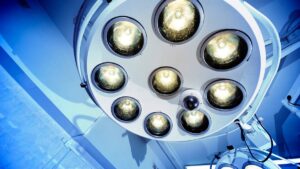Mach 7 positions for enterprise imaging uptake solving tomorrow’s problems with today’s software

Pic: Getty Images
- Mach7 primed for growth as move towards enterprise rather than departmental imaging grows
- Company’s three modular products are a unique fit for use case of enterprise imaging
- Mach7 landing big clients as it works to solve tomorrow’s problems with today’s software
ASX-listed health imaging company Mach7 (ASX:M7T) is changing medical imaging with its enterprise solutions and filling connectivity gaps created by siloed departmental imaging.
Visiting Australia from the US this week, M7T CEO Mike Lampron told Stockhead historically in medical imaging each department tended to have their medical imaging solutions but they weren’t being easily shared.
“80% of the images produced in a hospital are produced out of the radiology department,” he said.
“So that’s why we’ve always had these radiology-specific solutions so when we start to think of enterprise solutions it incorporates images that are being captured throughout the whole hospital.
“So if you think of dermatology as an example they may be taking photos of the patient and they are essentially digital images which may be captured on camera and often saved as a JPEG just to a hard drive on a device within the department. ”
But Lampron said it could be of benefit to another doctor in a different department to see those images.
“It’s about consolidating images in one location and making them accessible to the clinician and that’s the value,” he said.
“It allows for a more complete medical record so the clinician can easily find them and know they are there rather than having them in a siloed solution where they may not have known the images existed.
“Maybe they’ll use it or maybe not but at least it’s accessible to them.”
M7T enterprise imaging solutions
M7T enterprise imaging solutions are broken up into three modules including:
- Vendor Neutral Archive (VNA)
- Universal Viewer
- Workflow Orchestration
“The Vendor Neutral Archive is the hub of our solution where all the data is managed,” Lampron said.
“The data is consolidated into the VNA and any manipulation to the data is done within the VNA and then it can be served back out in a more meaningful way.”
Lampron said the universal viewer is intended to work not just with M7T’s VNA but integrated into other third party solutions, primarily electronic medical records.
“It can also layer on top of these departmental pack solutions to give access to clinicians outside of the departments,” he said.
“For those hospitals on this enterprise journey they usually start with storing radiology studies in the VNA and then they start to move laterally within the hospital system to include other departments like dermatology, ophthalmology; it could be oncology, wound care or scope videos.”
Lampron said the workflow orchestration component is meant to help create department level workflow – establishing workflow for a point of care ultrasound in ICU, as an example.
“Those are our three our primary products and where we fit in this concept of enterprise imaging.”
Growing interest in enterprise imaging
Lampron said there seems to be more interest in enterprise imaging but just how quickly it will be adopted remains the big question.
“The industry is still focused on radiology but slowly moving towards enterprise imaging,” he said.
“It’s definitely a direction the industry is heading but just a matter of what speed are we going to go.”
Lampron said M7T feels its products are a unique fit for the use case of enterprise imaging.
“First of all we are vendor neutral and second of all our software is modular so you could deploy just a VNA or deploy two or all products,” he said.
“By having a modular product that can fit wherever the client is on their journey towards enterprise imaging, they can buy a product rather than forcing them to buy a complete ecosystem.
“We allow our clients to buy a best of breed solution to solve whatever problems they’re facing, realising not two hospitals are the same.
M7T started in 2010 started as a startup company in Burlington, Vermont in the US, then listing on the ASX in May 2016 through a reverse merger with ASX listed 3D Medical.
“From a corporate perspective the next major event was our acquisition of Client Outlook in June 2020,” Lampron said.
“That acquisition got us the universal viewer and prior to that Mach 7 was really a data management VNA company.”
Growing need for data
M7T is confident enterprise imaging will get a bigger foothold over the next three to five years with the rise of artificial intelligence and need for data.
“As hospitals start to think about how they’ll incorporate artificial intelligence, other advanced visualisation tools and third party tool sets the number one thing they’ll need is access to data,” Lampron said.
“As data becomes a bigger component the customer is going to think how can they monitor that data and how can these third party solutions be more helpful to them.”
Lampron said patient privacy will also be important with data needing to anonymised.
“The great thing about our VNA is as an example you can stratify the data. For example, say I want to see all the CT scans done on the brain with contrast from this date to this date and I want it anonymised,” he said.
“All that can be stored in an anonymised way and then if you have an AI algorithm you want to run against that data set, you could.”
“It’s stratifying and anonymising that data and preparing that data to be used.”
Landing BIG clients
M7T got off to a good start this year and surged 20% on January 3, the first trading day of 2023 after landing the largest customer contract in its history.
The company signed up Nasdaq-listed Akumin Inc, an outpatient radiology service provider in the US, as a new client, to deploy its entire cloud-based enterprise imaging platform for Akumin.
The total contract value is around $16.7 million, which will be staged annually across the life of the contract.
M7T also released solid H1 FY23 results with highlights including:
- Record half-yearly sales orders of $25.8m, up 17% on the pcp
- Annual Recurring Revenue was $20m, up 19% on pcp
- Bottom line EBITDA for the half was $3.4m, up 13% on pcp
“We’ve been cashflow positive for the past three years and expect to be again this year and have a positive EBITA,” Lampron said.
“We see our revenue growing at 20% and think our OpEx will only minimally grow year over year as we look to the two to three years out.
“We have made a lot of strides in the company and our business foundations are solid.”
He said competitors in the markets including the likes of GE, Fuji and Agfa are developing enterprise solutions based off their radiology departmental perspective.
“They’re still in the market, still own the lion’s share of the market but they have antiquated technologies getting older by the year,” he said.
“We see ourselves as a more innovative solution solving tomorrow’s problems with today’s software rather than solving today’s problem’s with yesterday’s software.”
The M7T share price today:

UNLOCK INSIGHTS
Discover the untold stories of emerging ASX stocks.
Daily news and expert analysis, it's free to subscribe.
By proceeding, you confirm you understand that we handle personal information in accordance with our Privacy Policy.








